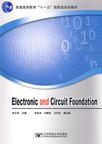电子电路基础
出版时间:2009-9 出版社:北京邮电大学出版社 作者:李立华 编 页数:325
前言
With the development of electronic and information technology, the Ministry of Education of China promotes bilingual teaching in high education to enhance the level of talents in electronic and information professions. This book is a Chinese-English bilingual teaching material for use in the core electronics courses of "Electronic and Circuit Foundation","Fundamentals of Analog Circuits" in high education for undergraduate electronic engineering,information technology and computer engineering majors. This book gives attention to the contents and teaching plan for both the Chinese and international tradition. This book is designed concisely and is suitable for teaching and experimenting within 40 -68 hours. The first three chapters include semiconductor basis and diodes, bipolar junction transistors and basic BJT amplifiers, field-effect transistors and basic amplifiers, which are appropriate for an entry to electronic devices as they present the basic knowledge of semiconductor elements as diodes and transistors. Chapter 4 covers differential amplifiers, multistage amplifiers and current sources, which is a profound introduction of analog circuits for constructing analog IC circuits. Chapter 5 goes deep into the frequency response of basic BJT and FET amplifiers. It gives a comprehensive introduction to the response of BJTs and FETs amplifiers to signals with low frequency, middle-range frequency and high frequency respectively. Chapter 6 introduces feedback concepts and negative feedback amplifiers. It shows not only the effects of negative feedback to amplifiers but trains an approximate analysis method which is commonly used in practical engineering cases. From Chapter 1 to Chapter 6, it pays attention to small signal amplification, while Chapter 7 introduces a kind of large signal amplifier as power amplifier. Therefore, the circuits analysis method in Chapter 7 is different from that introduced before. Chapter 8 takes operational amplifiers and comparators, which are commonly used in practical electronic circuits, to introduce basic informationof analog IC circuits. The application of operational amplifiers and comparators cover operational circuits and wave shaping circuits. Finally, Chapter 9 presents six electronic technology experiments to improve the understanding of the fundamental information of electronics and circuits as well as to exercise the application of common electronic devices and analysis methods. A lot of examples and problems are presented in each chapter to exercise the understanding of the basic electronic and circuit principles.
内容概要
This book is a Chinese-English bilingual teaching material for use in the courses of "Electronic and CircuitFoundation" ,"Fundamentals of Analog Circuits" for electronic and information professions, which is taught byEnglish mainly or Chinese and English both. This book is designed with valuable teaching experience from theteachers of "Electronic and Circuit Foundation" in the International School of Beijing University of Posts and Telecommunications. This book is designed concisely and gives more attention to the contents and teaching plan for Chinese tradition and is suitable for teaching and experimenting within 40~68 hours. This book includes semiconductor basis and diodes, bipolar junction transistors and basic BJT amplifiers,field-effect transistors and basic amplifiers, differential and multistage IC amplifiers, frequency response, feed-back amplifiers, power amplifiers, operational amplifiers and comparators and six electronic technology experi-ments. This book pays attention to basic theory and analysis methods for analog circuits, and emphasize on thecombination of theory analysis and experiments. The Chinese contents are consistent with the English content,with sufficient examples as a good reference for students and professional engineers.
书籍目录
第1章 半导体基础知识和二极管 1.1 半导体基础知识 1.1.1 本征半导体 1.1.2 杂质半导体 1.2 PN结原理及特性 1.2.1 PN结的形成原理 1.2.2 PN结的导电特性 1.3 半导体二极管 1.3.1 二极管特性 1.3.2 二极管的模型 1.3.3 二极管的等效电阻 1.3.4 稳压二极管 1.3.5 其他类型二极管 1.4 小结 习题第2章 双极型晶体管和基本双极型晶体管放大器 2.1 双极型晶体管 2.1.1 BJT结构 2.1.2 BJT特性 2.1.3 BJT工作模式 2.2 BJT直流偏置 2.2.1 直流分析 2.2.2 图解法 2.3 BJT交流分析 2.3.1 放大器基本原理 2.3.2 交流小信号等效电路 2.4 基本BJT放大器 2.4.1 BJT放大器工作组态 2.4.2 共射极放大器 2.4.3 共集电极放大器 2.4.4 共基极放大器 2.5 三种基本放大器组态:小结及比较 2.6 小结 习题第3章 场效应管 3.1 简介 3.2 场效应管的特性 3.2.1 结型场效应管 3.2.2 绝缘栅耗尽型场效应管 3.2.3 绝缘栅增强型场效应管 3.3 场效应管的直流电路分析 3.3.1 共源放大电路 3.3.2 自偏置电路 3.4 场效应管的交流等效分析 3.4.1 场效应管的小信号等效模型 3.4.2 共源极放大电路 3.4.3 自偏置电路 3.5 小结 习题第4章 差分放大器和多级集成电路放大器 4.1 镜像电流源 4.1.1 典型的镜像电流源 4.1.2 镜像电流源的应用 4.2 差分放大器 4.2.1 差分对的结构 4.2.2 直流分析 4.2.3 交流小信号等效电路分析 4.2.4 共模抑制比 4.2.5 带有源负载的差分放大器 4.3 多级放大器 4.3.1 耦合模式 4.3.2 直流偏置与多级放大器分析 4.3.3 多级放大器的交流分析 4.3.4 多级集成电路放大器的应用 4.4 小结 习题第5章 放大电路的频率响应第6章 反馈放大电路第7章 功率放大电路第8章 运算放大器和电压比较器第9章 实验参考文献
章节摘录
第1章 半导体基础知识和二极管 半导体器件是现代电子技术的重要组成部分,其中最基本的电子器件是PN结二极管。本章在简要介绍半导体基本知识的基础上,重点讨论PN结二极管的物理结构、工作原理、特性曲线和主要参数,并且利用二极管电路的一般特性及基本分析方法对简单的二极管电路进行分析。 1.1 半导体基础知识 1.1.1 本征半导体 自然界中的物质按其导电性可以分为导体、绝缘体和半导体。常温时,半导体的导电特性介于导体和优良绝缘体之间。在电子器件中使用最为广泛的半导体材料是:硅(si)、锗(Ge)和砷化镓(GaAs)。物质的导电性与其原子结构有关。任何物质的原子都是由原子核及其外层电子构成,其中最外层电子称为价电子。 硅原子有14个电子,锗原子有32个电子,它们的原子结构如图1.1所示。硅原子和锗原子都有四个价电子,属于四价元素。
图书封面
评论、评分、阅读与下载
用户评论 (总计2条)
- 中英对照之作,有兴趣可以看看
- 我们的课本 一本书中英文都有了 很合适 省的买两本了
